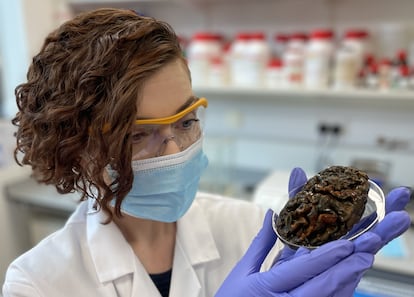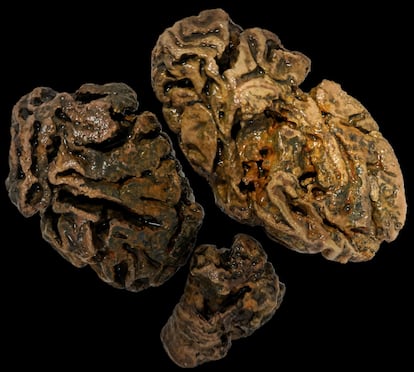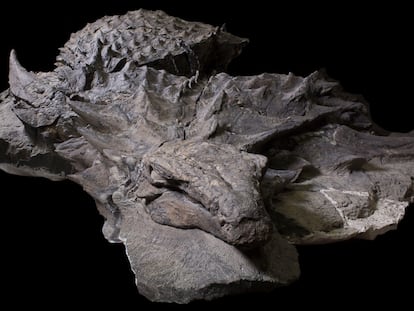Science fails to solve mystery of brains preserved for more than 12,000 years
The main mechanisms of conservation are known, but there are thousands of pieces that have been preserved for millennia without any knowledge of how it happened

Bones, teeth and even nails or hair are the main witnesses of the past. Soft tissues, internal organs, muscles, tendons and skin do not stand the test of time and decompose. Faced with this reality, a group of archaeologists and paleontologists have compiled a sample of thousands of soft body parts which shows that the brain is the best preserved of all. In a third of the cases, it is not clear how the brain has been able to endure up to 12,000 years. Researchers believe that there is something in the gray matter that acts as a preservative.
After reviewing archives, archaeological databases and hundreds of published research papers, the scientists gathered the information on the more than 13,000 soft body parts from 213 sites around the world. Of these, 4,405 were human brains, making them the most frequently sampled soft body part. In fact, more than a thousand brains were the only soft remains of the bodies found.
This large number of samples dismantle the idea that it is rare to find them in the fossil record. “Of course, having a preserved brain will be less common than skeletal or dental tissue!” says Alexandra Morton-Hayward, a forensic anthropologist at the University of Oxford (UK) and the lead author of the study, which was published in Proceedings of the Royal Society B Biological Sciences. But she adds that “brains considerably outperform other tissues reported during the same time period.”
Fossil brains have been found on every continent except Antarctica. Most of them were discovered in Europe, but they have also been preserved in other archaeologically important areas, such as the Andean mountain range, Ancient Egypt, the Middle East and the far east of Asia. By taking into account climatic variables, the researchers were able to investigate how tissues that, under normal conditions, should have disappeared in a few decades, were preserved. “In forensics, it is well established that the brain is one of the first organs to decompose after death,” recalls Morton-Hayward.
Most of the brains (38%) were preserved by dehydration, usually by heat. For example, 500 of the brains were preserved in an Egyptian necropolis dating back 6,150 years. The other preservation mechanism is saponification. Under certain environmental conditions, the fats in the body, the adipose tissue — 98% of which is made up of triglycerides — are converted into adipocere or grave wax. It is this wax that was able to preserve 30% of the brain tissue investigated.
This is a large number, but they were only found them in seven sites, with almost all of them discovered (1,200) in a medieval cemetery in Paris. Two other preservation methods studied in the research accounted for just a small fraction of the fossil brains. Just 1.6% were preserved by freezing in areas such as Alaska and high mountains, such as the Andes or the Alps. While around 20 brains were preserved in peat bogs in humid areas of Europe.
But 1,328 brains — including the oldest in the sample, more than 12,000 years old — had been preserved thanks to an “unknown” mechanism, according to the research. The researchers investigated the cause, but they did not match any of the four identified processes. Nor did they find specific environmental conditions that would explain the brain’s conservation. What’s more, the brains were discovered in a wide variety of sites, including graves, burial mounds, shipwrecks, wooden and lead coffins, common and shallow graves, and in fragmentary remains and severed heads. The samples do not even have latitude or climatic conditions in common, although the presence of clay and iron at these sites could explain some cases.

“The unknown samples have few factors in common, although waterlogging and the presence of clays and iron in the burial environment are occasionally mentioned,” Morton-Hayward notes. “What distinguishes them from other types of preservation is that they are the only soft tissue remaining, suggesting a mode of preservation unique to the central nervous system,” she adds. Indeed, of the 1,328 brain remains that were preserved thanks to an unknown mechanism, 1,308 were the only soft remains found next to bones or teeth. “Moreover, the absence of unifying environmental factors points to something in the brain itself (perhaps its biochemical composition during life) underpins this unknown mechanism and facilitates its preservation after death,” the British researcher concludes.
This will be the second part of this story. The researchers want to find those elements or endogenous mechanisms that give greater longevity to brain tissue. While it is true that the skull temporarily shelters the brain from the environmental action, but the heart and the tongue are also protected, and there were no cases of them.
Another element is even more mysterious and reinforces the theory that the mechanism comes from the brain itself: on average, the sites where the brains were found have higher levels of precipitation than the other sites and humidity is one of the environmental factors that most accelerate the putrefaction of organic material. One possibility according to the researchers is that the brain is preserved by a chemical interaction between various elements, such as proteins and lipids, mediated by iron. All three are abundant in gray matter and would be the key to its preservation.
Sign up for our weekly newsletter to get more English-language news coverage from EL PAÍS USA Edition
Tu suscripción se está usando en otro dispositivo
¿Quieres añadir otro usuario a tu suscripción?
Si continúas leyendo en este dispositivo, no se podrá leer en el otro.
FlechaTu suscripción se está usando en otro dispositivo y solo puedes acceder a EL PAÍS desde un dispositivo a la vez.
Si quieres compartir tu cuenta, cambia tu suscripción a la modalidad Premium, así podrás añadir otro usuario. Cada uno accederá con su propia cuenta de email, lo que os permitirá personalizar vuestra experiencia en EL PAÍS.
¿Tienes una suscripción de empresa? Accede aquí para contratar más cuentas.
En el caso de no saber quién está usando tu cuenta, te recomendamos cambiar tu contraseña aquí.
Si decides continuar compartiendo tu cuenta, este mensaje se mostrará en tu dispositivo y en el de la otra persona que está usando tu cuenta de forma indefinida, afectando a tu experiencia de lectura. Puedes consultar aquí los términos y condiciones de la suscripción digital.
More information

What can fossils teach us about biodiversity?

The strange case of the mummified dinosaurs
Últimas noticias
The metaverse, four years later: Is it finished or just at a standstill?
$3,000 and a plane ticket: The United States increases incentives for migrants to self-deport before the end of the year
Charles Dubouloz, mountaineering star, retires at 36 with a farewell tour inspired by Walter Bonatti
From the White House to diplomatic gifts: Lego wins over adult fans, brick by brick
Most viewed
- The low-cost creative revolution: How technology is making art accessible to everyone
- Christian Louboutin: ‘Young people don’t want to be like their parents. And if their parents wear sneakers, they’re going to look for something else’
- All the effects of gentrification in one corner of Mexico’s Colonia Roma
- Liset Menéndez de la Prida, neuroscientist: ‘It’s not normal to constantly seek pleasure; it’s important to be bored, to be calm’
- Christmas loses its festive spirit: ICE fears cast shadow over religious celebrations









































